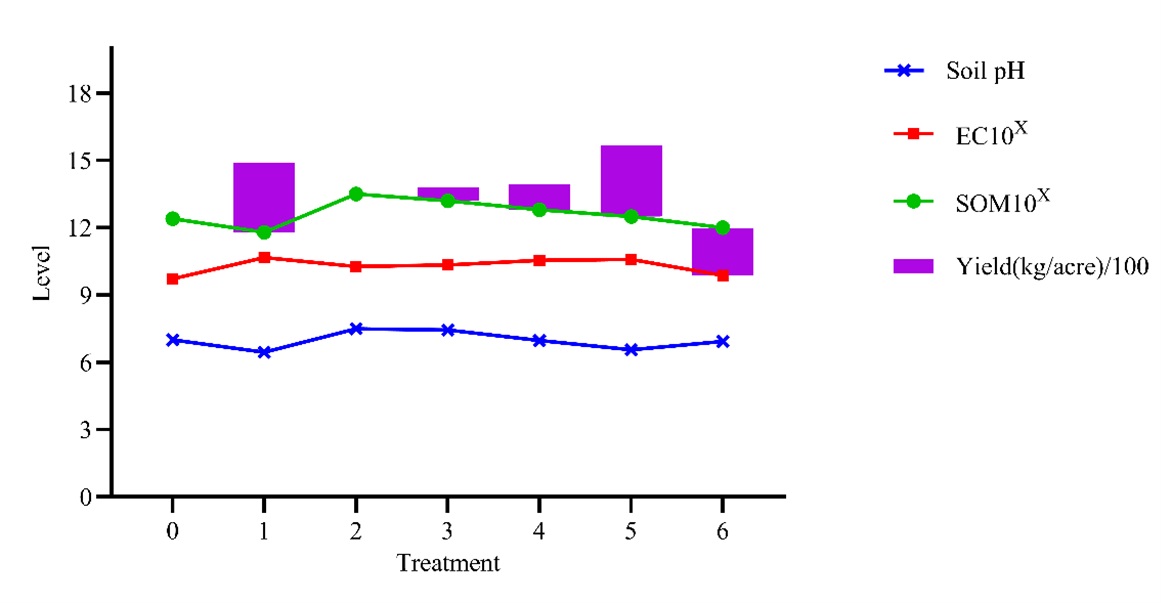
Nicodemus M. Musyoka
Department of Soil Science, Faculty of Agriculture at Kamphaeng Saen, Kasetsart University, Nakhon Pathom, Thailand
Suphachai Amkha
Department of Soil Science, Faculty of Agriculture at Kamphaeng Saen, Kasetsart University, Nakhon Pathom, Thailand
DOI: https://doi.org/10.14456/apst.2025.1
Keywords: Crop yield Soil electrical conductivity Soil organic matter Soil pH
Abstract
The aim of this research was to comprehend the impacts of fertilizers in fostering sustainable agriculture, aiming to enhance crop output while safeguarding the environment. Investigating the effects of chemical fertilizers and chicken compost on mung bean yield and soil chemical properties, six treatments were administered across “KUML4” mung bean. Statistical analysis revealed substantial variations in soil pH, electrical conductivity, and organic matter content among the treatments. Notably, the exclusive use of chemical fertilizers triggered a 9.9% increase in soil electrical conductivity, accompanied by decreases in pH and organic matter content. Conversely, chicken compost stabilized pH levels in slightly acidic soils and significantly boosted soil organic matter. Optimal mung bean yield, experiencing a 31% increase compared to the control treatment, was achieved by combining 75% chemical fertilizers with 25% chicken compost. Crucially, synergizing chicken compost with chemical fertilizers notably improved soil chemical properties, while a combination of 75% chemical fertilizers and 25% chicken compost optimized mung bean yield. These findings highlight the potential of integrating chicken compost with chemical fertilizers as a promising strategy for sustainable agriculture, emphasizing both soil chemical enhancement and yield improvement.
How to Cite
Musyoka , N. M., & Amkha, S. (2024). Deciphering chemical fertilizers and chicken compost effects on soil chemical properties and mung bean yield under ideal moisture conditions. Asia-Pacific Journal of Science and Technology, 30(01), APST–30. https://doi.org/10.14456/apst.2025.1
References
Brouwer ID, McDermott J, Ruben R. Food systems everywhere: Improving relevance in practice. Glob Food Sec. 2020;26:100398.
Selwyn B. A green New Deal for agriculture. In: Tienhaara K, Robinson J, editors. Routledge Handbook on the Green New Deal. London: Routledge; 2022. p. 88–107.
Giller KE, Hijbeek R, Andersson JA, Sumberg J. Regenerative agriculture: An agronomic perspective. Outlook Agric. 2021;50(1):13-25.
Baligar V, Fageria N, He Z. Nutrient use efficiency in plants. Commun Soil Sci Plant Anal. 2001;32(7-8):921-950.
Ju X-T, Xing G-X, Chen X-P, Zhang S-L, Zhang L-J, Liu X-J, et al. Reducing environmental risk by improving N management in intensive Chinese agricultural systems. Proc Natl Acad Sci U S A. 2009;106(9): 3041-3046.
Reeve JR, Hoagland LA, Villalba JJ, Carr PM, Atucha A, Cambardella C, et al. Organic farming, soil health, and food quality: considering possible links. Adv Agron. 2016;137:319-367.
Sainju UM, Liptzin D. Relating soil chemical properties to other soil properties and dryland crop production. Front Environ Sci. 2022;10:1005114.
Assefa ZB, Dinku AM, Jemal AM. Value chain analysis of Mung Bean (Vigna radiata L. Wilczek thrive) in Kalu Woreda, Ethiopia. Agric Food Secur. 2022;11(1):54.
Lal R, Bouma J, Brevik E, Dawson L, Field DJ, Glaser B, et al. Soils and sustainable development goals of the United Nations: An International Union of Soil Sciences perspective. Geoderma Reg. 2021;25:e00398.
Dikr W. Mung Bean (Vigna radiata L.) Production status and challenges in Ethiopia. Glob Acad J Agri Biosci. 2023;5(2):13-22.
Islam MR, Kamal MM, Alam MA, Hossain J, Soufan W, Skalicky M, et al. Physiochemical changes of Mung bean [Vigna radiata (L.) R. wilczek] in responses to varying irrigation regimes. Horticulturae. 2021;7(12):565.
Poudel S. Organic matter determination (Walkley-Black method) [Internet]. 2020 [cited 2023 Dec 12]. Available from: https://doi.org/10.13140/RG.2.2.22043.00807
Alam SM, Naqvi SSM, Ansari R. Impact of soil pH on nutrient uptake by crop plants. In: Pessarakli, editor. Handbook of plant and crop stress. New York: Marcel Dekker, Inc; 1999. p. 51-60.
FAO. Salt-affected soils map symposium [Internet]. 2021 [cited 2023 Dec 12]. Available from: https://www.fao.org/ newsroom/detail/salt-affected-soils-map-symposium/en.
Xu X, Guo L, Wang S, Wang X, Ren M, Zhao P, et al. Effective strategies for reclamation of saline-alkali soil and response mechanisms of the soil-plant system. Sci Total Environ. 2023;905:167179.
Dikr W. Mung Bean (Vigna radiata L.) Production Status and Challenges in Ethiopia. Glob Acad J Agri Biosci. 2023;5(2):13-22.
Dewangan SK, Shrivastava S, Kumari L, Minj P, Kumari J, Sahu R. The effects of soil pH on soil health and environmental sustainability: A Review. J Emerg Technol Innov Res. 2023;10(6):611-616.
Singh G, Mavi MS, Choudhary OP, Gupta N, Singh Y. Rice straw biochar application to soil irrigated with saline water in a cotton-wheat system improves crop performance and soil functionality in north-west India. J Environ Manage. 2021;295:113277.
Hernandez-Soriano MC, Dalal RC, Warren FJ, Wang P, Green K, Tobin MJ, et al. Soil organic carbon stabilization: Mapping carbon speciation from intact microaggregates. Environ Sci Technol. 2018;52(21): 12275-12284.
Xiang L, Harindintwali JD, Wang F, Redmile-Gordon M, Chang SX, Fu Y, et al. Integrating biochar, bacteria, and plants for sustainable remediation of soils contaminated with organic pollutants. Environ Sci Technol. 2022;56(23):16546-16566.
Rinot O, Levy GJ, Steinberger Y, Svoray T, Eshel G. Soil health assessment: A critical review of current methodologies and a proposed new approach. Sci Total Environ. 2019;648:1484-1491.

Published:
License
This work is licensed under a Creative Commons Attribution-NonCommercial-NoDerivatives 4.0 International License.
